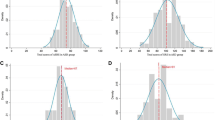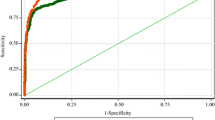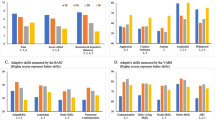Abstract
Autism spectrum disorder (ASD) as well as oppositional defiant (ODD) and conduct disorder (CD) is characterised by difficulties in social interaction with peers. The Social Responsiveness Scale (SRS) measures reciprocal social behaviour in children and adolescents and was originally developed as a quantitative measure of autistic traits. In the present study, we compare parent-rated SRS scores in children with ODD, CD, and ASD and examine the diagnostic validity of the SRS alone and in combination with additional questionnaires to differentiate between groups. We hypothesize that the SRS better differentiates ASD and typically developing controls (TD) than ASD and the disruptive behaviour disorders ODD and CD. The sample consists of three clinical groups: ASD without comorbid intellectual delay (N = 55), ODD/CD (N = 55), and TD (N = 55), between 6 and 18 years. The groups were matched by age, sex, and IQ. SRS scores were compared for the three groups. Sensitivity and specificity of the SRS total and sub-scores were examined by receiver operating characteristics (ROC) analyses. Logistic regression analyses were calculated for estimating the rate of correctly specified individuals. The SRS differentiated excellently between ASD and TD (ROC-AUC = 1.00), but sensitivity and specificity were considerably lower when ASD was compared with ODD/CD (ROC-AUC = 0.82). A combination of three parent-rated questionnaires resulted in an improved validity to differentiate ASD and ODD/CD. For clinical screening purposes in children suspicious of ASD and/or ODD/CD, the SRS should be used in combination with additional disorder-specific questionnaires to improve the rate of correct classification of both disorders.



Similar content being viewed by others
References
Achenbach TM (1998) Elternfragebogen über das Verhalten von Kindern und Jugendlichen; Deutsche Bearbeitung der Child Behaviour Checklist (CBCL/4-18). Arbeitsgruppe Kinder-, Jugend- und Familiendiagnostik, Köln
Adams C, Green J, Gilchrist A, Cox A (2002) Conversational behaviour of children with Asperger syndrome and conduct disorder. J Child Psychol Psychiatry 43(5):679–690
Adornetto C, In-Albon T, Schneider S (2008) Diagnostik im Kindes- und Jugendalter anhand strukturierter Interviews: Anwendung und Durchführung des Kinder-Dips. Klinische Diagnostik und Evaluation 1(4):363–377
American Psychiatric Association (2000) Diagnostic and statistical manual of mental disorders, 4th ed., text revision. American Psychiatric Association, Washington, DC
Aster M, Neubauer A, Horn R (2006) Wechsler Intelligenztest für Erwachsene (WIE). Harcourt Test Services, Frankfurt a. Main
Bölte S, Poustka F (2006) Fragebogen zur Sozialen Kommunikation—Autismus Screening (FSK). Deutsche Fassung des Social Communication Questionnaire (SCQ). Hans Huber, Hogrefe AG, Bern
Bölte S, Poustka F (2008) Skala zur Erfassung Sozialer Reaktivität (SRS). Hans Huber, Hogrefe AG, Bern
Bölte S, Crecelius K, Poustka F (2000) Der Fragebogen über Verhalten und soziale Kommunikation: psychometrische Eigenschaften eines Autismus-Screening-Instruments für Forschung und Praxis. Diagnostica 46:149–155
Bölte S, Dickhut H, Poustka F (1999) Patterns of parent-reported problems indicative in autism. Psychopathology 32:94–98
Bölte S, Poustka F, Constantino JN (2008) Assessing autistic traits: cross-cultural validation of the social responsiveness scale (SRS). Autism Res 1:354–363
Bölte S, Rühl D, Schmötzer G, Poustka F (2006) Diagnostisches Interview für Autismus—Revidiert. Deutsche Fassung des Autism Diagnostic Interview—Revised von Michael Rutter, Ann LeCouteur und Catherine Lord, 1. Auflage. Hans Huber, Hogrefe AG, Bern
Bölte S, Westerwald E, Holtmann M, Freitag C, Poustka F (2011) Autistic traits and autism spectrum disorders: the validity of two measures presuming a continuum of social communication skills. J Autism Dev Disord 42(1):66–72
Charman T, Baird G, Siminoff E, Loucas T, Chandler S, Meldrum D, Pickles A (2007) Efficacy of three screening instruments in the identification of autistic-spectrum disorders. Br J Psychiatry 191:554–559
Constantino JN, Gruber CP (2005) Social responsiveness scale. Western Psychological Services, Los Angeles
Constantino JN, Hudziak JJ, Todd RD (2003) Deficits in reciprocal social behaviour in male twins: evidence for a genetically independant domain of psychopathology. J Am Acad Child Adolesc Psychiatry 42(4):458–467
Constantino JN, Przybeck T, Friesen D, Todd R (2000) Reciprocal social behaviour in children with and without pervasive developmental disorders. Dev Behav Pediatr 21(1):2–11
Constantino J, Davis S, Todd R, Schindler M, Cross M, Brophy S et al (2003) Validation of a brief measure of autistic traits: comparison of the social responsiveness scale with the autism diagnostic interview-revised. J Autism Dev Disord 33(4):427–433
Corsello C, Hus V, Pickels A, Risi S, Cook EH, Leventhal BL et al (2007) Between a ROC and a hard place: decision making and making decisions about using the SCQ. J Child Psychol Psychiatry 48:932–940
Döpfner M, Görtz-Dorten A, Lehmkuhl G (2008) DISYPS-II: Diagnostik System für psychische Störungen nach ICD-10 und DSM-IV für Kinder und Jugendliche-II. Huber, Göttingen
Döpfner M, Schmeck K, Berner W (1994) Handbuch: Elternfragebogen über das Verhalten von Kindern und Jugendlichen. Forschungsergebnisse zur deutschen Fassung der Child Behaviour Checklist (CBCL/4-18). Arbeitsgruppe Kinder-, Jugend- und Familiendiagnostik, Köln
Eaves L, Rutter M, Silberg J, Shillady L, Maes H, Pickles A (2000) Genetic and environmental causes of covariation in interview assessments of disruptive behaviour in child and adolescent twins. Behav Genet 30(4):321–334
Grzadzinski R, Di Martino A, Brady E, Mairena MA, O’Neale M, Petkova E, Lord C, Castellanos FX (2011) Examining autistic traits in children with ADHD: does the autism spectrum extend to ADHD? J Autism Dev Disord 41:1178–1191
Ho A, Todd RD, Constantino JN (2005) Brief report: autistic traits in twins vs non-twins—a preliminary study. J Autism Dev Disord 35:129–133
Hus V, Bishop S, Gotham K, Huerta M, Lord C (2013) Factors influencing scores on the social responsiveness scale. J Child Psychol Psychiatry 54:216–224
Kanne SM, Abbacchi AM, Constantino JN (2009) Multi-informant ratings of psychiatric symptom severity in children with autism spectrum disorders: the importance of environmental context. J Autism Dev Disord 39:856–864
Lecavalier L (2006) Behavioural and emotional problems in young people with pervasive developmental disorders: relative prevalence, effects of subject characteristics, and empirical classification. J Autism Dev Disord 36:1101–1114
Lecavalier L, Gadow KD, DeVincent CJ, Edwards MC (2009) Validation of DSM-IV model of psychiatric syndromes in children with autism spectrum disorders. J Autism Dev Disord 39:278–289
Lord C, Rutter M, DiLavore P, Risi S (2001) Autism diagnostic observation schedule (ADOS). Western Psychological Services, Los Angeles
Mandell DS, Ittenbach RF, Levy SE, Pinto-Martin JA (2007) Disparities in diagnoses received prior to a diagnosis of autism spectrum disorder. J Autism Dev Disord 37(9):1795–1802
Peterman F (2010) Störung des Sozialverhaltens. In: Mattejat F (ed) Lehrbuch der Psychotherapie, 4th edn. CIP Medien, München
Petermann F, Petermann U (2010) Hamburg-Wechsler-Intelligenztest für Kinder-IV. Hans Huber, Bern
Risi S, Lord C, Gotham K, Corsello C, Chrysler C, Szatmari P, Cook E, Bennett L, Leventhal MD, Pickles A (2006) Combining information of multiple sources in the diagnosis of autism spectrum disorders. J Am Acad Child Adolesc Psychiatry 45(9):1094–1103
Rühl D, Bölte S, Feineis-Matthews S, Poustka F (2004) Diagnostische Beobachtungsskala für Autistische Störungen. Deutsche Fassung der Autism Diagnostic Observation Schedule. Hans Huber, Hogrefe AG, Bern
Rutter M, Bailey A, Lord C (2003) Social communication questionnaire (SCQ). Western Psychological Services, Los Angeles
Rutter M, LeCouteur A, Lord C (2003) Autism diagnostic interview-revised (ADI-R). Western Psychological Services, Los Angeles
Schneider S, Unnewehr S, Margraf J (2009) Diagnostisches interview bei psychischen Störungen im Kindes- und Jugendalter, 2nd edn. Springer Verlag, Heidelberg
Schwenck C, Mergenthaler J, Keller K, Zech J, Salehi S, Taurines R, Romanos M, Schecklmann M, Schneider W, Warnke A, Freitag CM (2012) Empathy in children with autism and conduct disorder: group-specific profiles and developmental aspects. J Child Psychol Psychiatry 53(6):651–659
Simonoff E, Pickles A, Charman T, Chandler S, Loucas T, Baird G (2008) Psychiatric disorders in children with autism spectrum disorders: prevalence, comorbidity and associated factors in a population-derived sample. J Am Acad Child Adolesc Psychiatry 47(8):568–572
Towbin KE, Pradella A, Gorrindo T, Pine DS, Leibenluft E (2005) Autism spectrum traits in children with mood and anxiety disorders. J Child Adolesc Psychopharmacol 15(3):452–464
Wang J, Lee L-C, Chen Y-S, Hsu J-W (2012) Assessing autistic traits in a Taiwan preschool population: cross-cultural validation of the social responsiveness scale (SRS). J Autism Dev Disord 42(11):2450–2459
Weiss RH (2006) CFT 20-R: Grundintelligenz Skala 2-Revision. Hogrefe, Göttingen
World Health Organisation (1992) International statistical classification of diseases and related health problems Rev. 10. World Health Organisation, Geneva
Acknowledgments
The authors gratefully acknowledge all families and their children who took part in this study. The authors also thank Laura Mojica and Eva Westerwald for their support in data collection. The study was supported by a grant of the Medical Faculty of the JW Goethe University Frankfurt am Main (Heinrich and Fritz Riese foundation)
Conflict of interest
The authors declare that they have no conflict of interest.
Author information
Authors and Affiliations
Corresponding author
Rights and permissions
About this article
Cite this article
Cholemkery, H., Kitzerow, J., Rohrmann, S. et al. Validity of the social responsiveness scale to differentiate between autism spectrum disorders and disruptive behaviour disorders. Eur Child Adolesc Psychiatry 23, 81–93 (2014). https://doi.org/10.1007/s00787-013-0427-5
Received:
Accepted:
Published:
Issue Date:
DOI: https://doi.org/10.1007/s00787-013-0427-5




